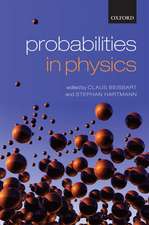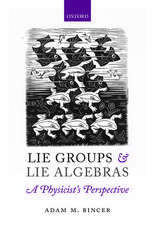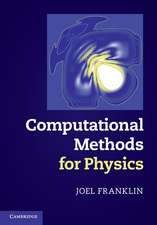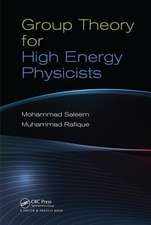Precisely Predictable Dirac Observables: Fundamental Theories of Physics, cartea 154
Autor Heinz Otto Cordesen Limba Engleză Hardback – 18 oct 2006
| Toate formatele și edițiile | Preț | Express |
|---|---|---|
| Paperback (1) | 640.37 lei 6-8 săpt. | |
| SPRINGER NETHERLANDS – 18 noi 2010 | 640.37 lei 6-8 săpt. | |
| Hardback (1) | 646.75 lei 6-8 săpt. | |
| SPRINGER NETHERLANDS – 18 oct 2006 | 646.75 lei 6-8 săpt. |
Din seria Fundamental Theories of Physics
- 20%
 Preț: 1002.37 lei
Preț: 1002.37 lei -
 Preț: 426.56 lei
Preț: 426.56 lei - 20%
 Preț: 819.48 lei
Preț: 819.48 lei - 18%
 Preț: 779.26 lei
Preț: 779.26 lei - 18%
 Preț: 955.25 lei
Preț: 955.25 lei - 18%
 Preț: 950.52 lei
Preț: 950.52 lei - 24%
 Preț: 794.89 lei
Preț: 794.89 lei - 18%
 Preț: 948.47 lei
Preț: 948.47 lei - 15%
 Preț: 589.80 lei
Preț: 589.80 lei - 18%
 Preț: 1229.73 lei
Preț: 1229.73 lei - 15%
 Preț: 587.83 lei
Preț: 587.83 lei - 18%
 Preț: 1236.06 lei
Preț: 1236.06 lei - 18%
 Preț: 946.87 lei
Preț: 946.87 lei -
 Preț: 394.87 lei
Preț: 394.87 lei - 18%
 Preț: 954.93 lei
Preț: 954.93 lei - 18%
 Preț: 1241.10 lei
Preț: 1241.10 lei - 18%
 Preț: 954.93 lei
Preț: 954.93 lei - 18%
 Preț: 953.35 lei
Preț: 953.35 lei - 18%
 Preț: 948.92 lei
Preț: 948.92 lei - 15%
 Preț: 648.05 lei
Preț: 648.05 lei - 18%
 Preț: 1232.09 lei
Preț: 1232.09 lei - 18%
 Preț: 996.78 lei
Preț: 996.78 lei - 18%
 Preț: 946.41 lei
Preț: 946.41 lei - 15%
 Preț: 640.24 lei
Preț: 640.24 lei - 15%
 Preț: 636.80 lei
Preț: 636.80 lei -
 Preț: 391.79 lei
Preț: 391.79 lei - 18%
 Preț: 780.19 lei
Preț: 780.19 lei -
 Preț: 391.79 lei
Preț: 391.79 lei - 15%
 Preț: 649.06 lei
Preț: 649.06 lei -
 Preț: 397.76 lei
Preț: 397.76 lei - 24%
 Preț: 586.69 lei
Preț: 586.69 lei - 15%
 Preț: 644.95 lei
Preț: 644.95 lei - 18%
 Preț: 1228.15 lei
Preț: 1228.15 lei
Preț: 646.75 lei
Preț vechi: 760.88 lei
-15% Nou
Puncte Express: 970
Preț estimativ în valută:
123.77€ • 128.24$ • 103.30£
123.77€ • 128.24$ • 103.30£
Carte tipărită la comandă
Livrare economică 21 martie-04 aprilie
Preluare comenzi: 021 569.72.76
Specificații
ISBN-13: 9781402051685
ISBN-10: 1402051689
Pagini: 294
Ilustrații: XIX, 269 p.
Dimensiuni: 155 x 235 x 20 mm
Greutate: 0.59 kg
Ediția:2007
Editura: SPRINGER NETHERLANDS
Colecția Springer
Seria Fundamental Theories of Physics
Locul publicării:Dordrecht, Netherlands
ISBN-10: 1402051689
Pagini: 294
Ilustrații: XIX, 269 p.
Dimensiuni: 155 x 235 x 20 mm
Greutate: 0.59 kg
Ediția:2007
Editura: SPRINGER NETHERLANDS
Colecția Springer
Seria Fundamental Theories of Physics
Locul publicării:Dordrecht, Netherlands
Public țintă
Academic/professional/technical: Research and professionalCuprins
Dirac Observables and ?do-s.- Why Should Observables be Pseudodifferential?.- Decoupling with ?do-s.- Smooth Pseudodifferential Heisenberg Representation.- The Algebra of Precisely Predictable Observables.- Lorentz Covariance of Precise Predictability.- Spectral Theory of Precisely Predictable Approximations.- Dirac and Schrödinger Equations; a Comparison.
Recenzii
From the reviews:
"In this very interesting book, the author proposes a modification of Dirac’s theory of the electron, that he believes to be free of the systematic well-known difficulties that give rise to the usual paradoxes. … the direction he describes in this book is promising, and will hopefully open the way to the construction of a more general framework." (Alberto Parmeggiani, Mathematical Reviews, Issue 2008 j)
"In this book Heinz Otto Cordes tries to make a contribution from the point of view of a mathematician, and it is certainly an interesting one. … it is very pleasant reading for the more mathematically inclined person, and those with some interest in physics will enjoy the many insightful remarks about quantum mechanics immersed in the text. I warmly recommend this book to mathematicians and mathematical physicists interested in the Dirac equation." (Bernd Thaller, SIAM Review, Vol. 50 (2), 2008)
"In this very interesting book, the author proposes a modification of Dirac’s theory of the electron, that he believes to be free of the systematic well-known difficulties that give rise to the usual paradoxes. … the direction he describes in this book is promising, and will hopefully open the way to the construction of a more general framework." (Alberto Parmeggiani, Mathematical Reviews, Issue 2008 j)
"In this book Heinz Otto Cordes tries to make a contribution from the point of view of a mathematician, and it is certainly an interesting one. … it is very pleasant reading for the more mathematically inclined person, and those with some interest in physics will enjoy the many insightful remarks about quantum mechanics immersed in the text. I warmly recommend this book to mathematicians and mathematical physicists interested in the Dirac equation." (Bernd Thaller, SIAM Review, Vol. 50 (2), 2008)
Textul de pe ultima copertă
This work presents a "Clean Quantum Theory of the Electron", based on Dirac’s equation. "Clean" in the sense of a complete mathematical explanation of the well known paradoxes of Dirac’s theory, and a connection to classical theory, including the motion of a magnetic moment (spin) in the given field, all for a charged particle (of spin ½) moving in a given electromagnetic field.
This theory is relativistically covariant, and it may be regarded as a mathematically consistent quantum-mechanical generalization of the classical motion of such a particle, à la Newton and Einstein. Normally, our fields are time-independent, but also discussed is the time-dependent case, where slightly different features prevail. A "Schroedinger particle", such as a light quantum, experiences a very different (time-dependent) "Precise Predictablity of Observables". An attempt is made to compare both cases. There is not the Heisenberg uncertainty of location and momentum; rather, location alone possesses a built-in uncertainty of measurement.
Mathematically, our tools consist of the study of a pseudo-differential operator (i.e. an "observable") under conjugation with the Dirac propagator: such an operator has a "symbol" approximately propagating along classical orbits, while taking its "spin" along. This is correct only if the operator is "precisely predictable", that is, it must approximately commute with the Dirac Hamiltonian, and, in a sense, will preserve the subspaces of electronic and positronic states of the underlying Hilbert space.
Audience:
Theoretical Physicists, specifically in Quantum Mechanics.
Mathematicians, in the fields of Analysis, Spectral Theory of Self-adjoint differential operators, and Elementary Theory of Pseudo-Differential Operators
This theory is relativistically covariant, and it may be regarded as a mathematically consistent quantum-mechanical generalization of the classical motion of such a particle, à la Newton and Einstein. Normally, our fields are time-independent, but also discussed is the time-dependent case, where slightly different features prevail. A "Schroedinger particle", such as a light quantum, experiences a very different (time-dependent) "Precise Predictablity of Observables". An attempt is made to compare both cases. There is not the Heisenberg uncertainty of location and momentum; rather, location alone possesses a built-in uncertainty of measurement.
Mathematically, our tools consist of the study of a pseudo-differential operator (i.e. an "observable") under conjugation with the Dirac propagator: such an operator has a "symbol" approximately propagating along classical orbits, while taking its "spin" along. This is correct only if the operator is "precisely predictable", that is, it must approximately commute with the Dirac Hamiltonian, and, in a sense, will preserve the subspaces of electronic and positronic states of the underlying Hilbert space.
Audience:
Theoretical Physicists, specifically in Quantum Mechanics.
Mathematicians, in the fields of Analysis, Spectral Theory of Self-adjoint differential operators, and Elementary Theory of Pseudo-Differential Operators
Caracteristici
A successful attempt to provide a Clean Observable Theory for Dirac’s Equation, free of contradictions like "Zitterbewegung" The existence of an accurate split between physical states belonging to the electron and to the positron is discussed, as well as the fact that precisely predictable observables must preserve this split














